9.1: Introduction to Offal Identification and Fabrication
- Page ID
- 21260
\( \newcommand{\vecs}[1]{\overset { \scriptstyle \rightharpoonup} {\mathbf{#1}} } \)
\( \newcommand{\vecd}[1]{\overset{-\!-\!\rightharpoonup}{\vphantom{a}\smash {#1}}} \)
\( \newcommand{\id}{\mathrm{id}}\) \( \newcommand{\Span}{\mathrm{span}}\)
( \newcommand{\kernel}{\mathrm{null}\,}\) \( \newcommand{\range}{\mathrm{range}\,}\)
\( \newcommand{\RealPart}{\mathrm{Re}}\) \( \newcommand{\ImaginaryPart}{\mathrm{Im}}\)
\( \newcommand{\Argument}{\mathrm{Arg}}\) \( \newcommand{\norm}[1]{\| #1 \|}\)
\( \newcommand{\inner}[2]{\langle #1, #2 \rangle}\)
\( \newcommand{\Span}{\mathrm{span}}\)
\( \newcommand{\id}{\mathrm{id}}\)
\( \newcommand{\Span}{\mathrm{span}}\)
\( \newcommand{\kernel}{\mathrm{null}\,}\)
\( \newcommand{\range}{\mathrm{range}\,}\)
\( \newcommand{\RealPart}{\mathrm{Re}}\)
\( \newcommand{\ImaginaryPart}{\mathrm{Im}}\)
\( \newcommand{\Argument}{\mathrm{Arg}}\)
\( \newcommand{\norm}[1]{\| #1 \|}\)
\( \newcommand{\inner}[2]{\langle #1, #2 \rangle}\)
\( \newcommand{\Span}{\mathrm{span}}\) \( \newcommand{\AA}{\unicode[.8,0]{x212B}}\)
\( \newcommand{\vectorA}[1]{\vec{#1}} % arrow\)
\( \newcommand{\vectorAt}[1]{\vec{\text{#1}}} % arrow\)
\( \newcommand{\vectorB}[1]{\overset { \scriptstyle \rightharpoonup} {\mathbf{#1}} } \)
\( \newcommand{\vectorC}[1]{\textbf{#1}} \)
\( \newcommand{\vectorD}[1]{\overrightarrow{#1}} \)
\( \newcommand{\vectorDt}[1]{\overrightarrow{\text{#1}}} \)
\( \newcommand{\vectE}[1]{\overset{-\!-\!\rightharpoonup}{\vphantom{a}\smash{\mathbf {#1}}}} \)
\( \newcommand{\vecs}[1]{\overset { \scriptstyle \rightharpoonup} {\mathbf{#1}} } \)
\( \newcommand{\vecd}[1]{\overset{-\!-\!\rightharpoonup}{\vphantom{a}\smash {#1}}} \)
\(\newcommand{\avec}{\mathbf a}\) \(\newcommand{\bvec}{\mathbf b}\) \(\newcommand{\cvec}{\mathbf c}\) \(\newcommand{\dvec}{\mathbf d}\) \(\newcommand{\dtil}{\widetilde{\mathbf d}}\) \(\newcommand{\evec}{\mathbf e}\) \(\newcommand{\fvec}{\mathbf f}\) \(\newcommand{\nvec}{\mathbf n}\) \(\newcommand{\pvec}{\mathbf p}\) \(\newcommand{\qvec}{\mathbf q}\) \(\newcommand{\svec}{\mathbf s}\) \(\newcommand{\tvec}{\mathbf t}\) \(\newcommand{\uvec}{\mathbf u}\) \(\newcommand{\vvec}{\mathbf v}\) \(\newcommand{\wvec}{\mathbf w}\) \(\newcommand{\xvec}{\mathbf x}\) \(\newcommand{\yvec}{\mathbf y}\) \(\newcommand{\zvec}{\mathbf z}\) \(\newcommand{\rvec}{\mathbf r}\) \(\newcommand{\mvec}{\mathbf m}\) \(\newcommand{\zerovec}{\mathbf 0}\) \(\newcommand{\onevec}{\mathbf 1}\) \(\newcommand{\real}{\mathbb R}\) \(\newcommand{\twovec}[2]{\left[\begin{array}{r}#1 \\ #2 \end{array}\right]}\) \(\newcommand{\ctwovec}[2]{\left[\begin{array}{c}#1 \\ #2 \end{array}\right]}\) \(\newcommand{\threevec}[3]{\left[\begin{array}{r}#1 \\ #2 \\ #3 \end{array}\right]}\) \(\newcommand{\cthreevec}[3]{\left[\begin{array}{c}#1 \\ #2 \\ #3 \end{array}\right]}\) \(\newcommand{\fourvec}[4]{\left[\begin{array}{r}#1 \\ #2 \\ #3 \\ #4 \end{array}\right]}\) \(\newcommand{\cfourvec}[4]{\left[\begin{array}{c}#1 \\ #2 \\ #3 \\ #4 \end{array}\right]}\) \(\newcommand{\fivevec}[5]{\left[\begin{array}{r}#1 \\ #2 \\ #3 \\ #4 \\ #5 \\ \end{array}\right]}\) \(\newcommand{\cfivevec}[5]{\left[\begin{array}{c}#1 \\ #2 \\ #3 \\ #4 \\ #5 \\ \end{array}\right]}\) \(\newcommand{\mattwo}[4]{\left[\begin{array}{rr}#1 \amp #2 \\ #3 \amp #4 \\ \end{array}\right]}\) \(\newcommand{\laspan}[1]{\text{Span}\{#1\}}\) \(\newcommand{\bcal}{\cal B}\) \(\newcommand{\ccal}{\cal C}\) \(\newcommand{\scal}{\cal S}\) \(\newcommand{\wcal}{\cal W}\) \(\newcommand{\ecal}{\cal E}\) \(\newcommand{\coords}[2]{\left\{#1\right\}_{#2}}\) \(\newcommand{\gray}[1]{\color{gray}{#1}}\) \(\newcommand{\lgray}[1]{\color{lightgray}{#1}}\) \(\newcommand{\rank}{\operatorname{rank}}\) \(\newcommand{\row}{\text{Row}}\) \(\newcommand{\col}{\text{Col}}\) \(\renewcommand{\row}{\text{Row}}\) \(\newcommand{\nul}{\text{Nul}}\) \(\newcommand{\var}{\text{Var}}\) \(\newcommand{\corr}{\text{corr}}\) \(\newcommand{\len}[1]{\left|#1\right|}\) \(\newcommand{\bbar}{\overline{\bvec}}\) \(\newcommand{\bhat}{\widehat{\bvec}}\) \(\newcommand{\bperp}{\bvec^\perp}\) \(\newcommand{\xhat}{\widehat{\xvec}}\) \(\newcommand{\vhat}{\widehat{\vvec}}\) \(\newcommand{\uhat}{\widehat{\uvec}}\) \(\newcommand{\what}{\widehat{\wvec}}\) \(\newcommand{\Sighat}{\widehat{\Sigma}}\) \(\newcommand{\lt}{<}\) \(\newcommand{\gt}{>}\) \(\newcommand{\amp}{&}\) \(\definecolor{fillinmathshade}{gray}{0.9}\)Some offal dishes are considered delicacies in international cuisine. This includes foie gras, pâté, and sweetbreads. Other offal dishes remain part of traditional regional cuisine and may be consumed especially in connection with holidays such as the Scottish tradition of eating haggis on Robert Burns Day. Intestines are traditionally used as casings for sausages. In South Louisiana pork offal is necessary for the making of Boudin Blanc and Noix.
Depending on the context, offal may also refer to those parts of an animal carcass discarded after butchering or skinning. Offal not used directly for human or animal food is often processed in a rendering plant, producing material that is used for fertilizer or fuel or, in some cases, it may be added to commercially produced pet food. Table 37 lists the most common types of offal from the various species.
| Species | Common Offal | Uses/Notes |
|---|---|---|
| Beef | Heart | Beef offal is more commonly retailed - Heart is a muscular offal. Cajun stuffed heart and Spanish Anticuchos grilled on a stick |
| Liver | Calf liver is favored. Liver is a glandular offal. Often sautéed with onions | |
| Kidney | Kidney is a glandular offal. Kidney pie is very European. | |
| Tongue | Tongue is a muscular offal. Called Lengua in Spanish; it cooks like pot roast and is great on authentic Latin tacos. Braise this. | |
| Tripe | Tripe is a muscular offal. Used widely in Asian, Latin, and Soul Food categories. |
|
| Oxtail | The only external offal meat and is muscular. Oxtail is braised in stews and soups. Very popular is Latin and Soul food cooking. | |
| Veal | Heart | See beef heart above. |
| Liver | Veal offal is more commonly served in restaurants than other types | |
| Kidney | See beef kidney above | |
| Tongue | See beef tongue above | |
| Brains | Brains can be prepared like sweetbreads. In the old deep south they were used to "stretch" the eggs when scrambled. | |
| Sweetbreads | Thymus gland is a glandular offal. Braise, sauté, grill, or fry after preparation technique. | |
| Pork | Liver | Pork offal is stronger in flavor; the liver is most commonly used in pâté. |
| Heart | See beef heart. | |
| Kidney | See beef kidney. | |
| Intestines | Used for sausage casing and chitterlings | |
| Skin | Used to make cracklings or chicharron | |
| Blood | Used for blood sausage and black pudding (Boudin noix) | |
| Lamb | Liver | Lamb offal is milder in flavor |
| Heart | Grilled, or braised | |
| Kidney | Kidney Pie | |
| Tongue | Grilled or used for pâté. | |
| Intestines | Used for sausage casings on smaller sausages | |
| Chicken | Heart, Liver, Gizzard, Feet | The first three are often referred to as giblets as a whole. Feet are external and have a large place in Asian and Soul food. |
| Duck/Goose | Liver/ Foie Gras | Fatter livers. Raised for centuries. Numerous uses both sweet and savory |
Liver: Liver is very fine textured and is almost devoid of the characteristic fiber bundles found in red meat (liver has no grain). Consequently, it is very tender and can be sliced in any direction
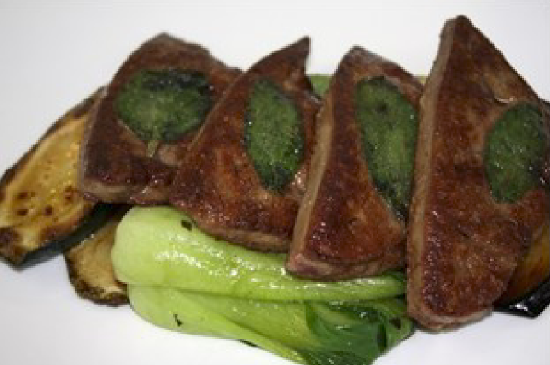
Grilled calf liver- Maxpixel
Kidney: Kidneys are either smooth, bean-shaped (in lamb and pork) or irregularly shaped with reddish-brown lobes and deep clefts (beef). Beef kidneys are very tough and require intense moist heat cookery.
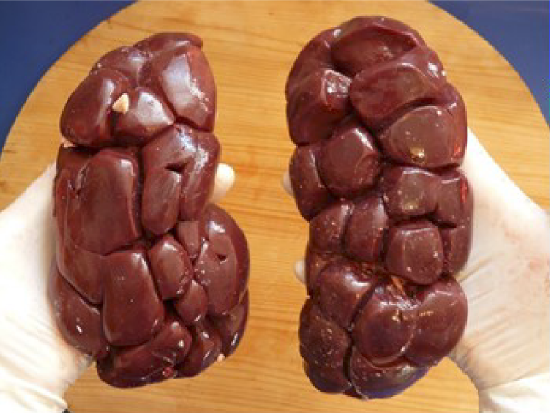
Beef Kidney - Pixabay
Heart: Heart is retailed whole, halved, or cut into slices depending on species and size. The inside of the heart contains string-like sinew, which should be removed if the heart is being stuffed and cooked. Dry heat is suitable for cooking heart. It is commonly stuffed and roasted whole or slices are seasoned and pan-fried.
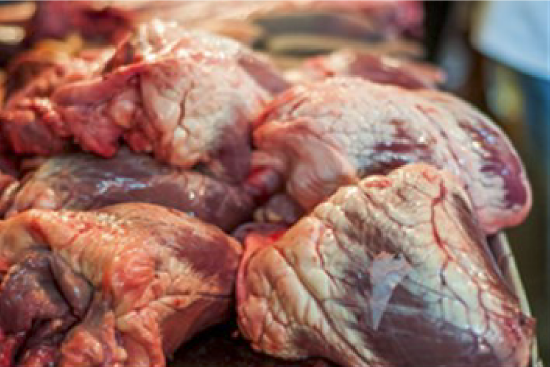
Beef Heart - Wikimedia Commons
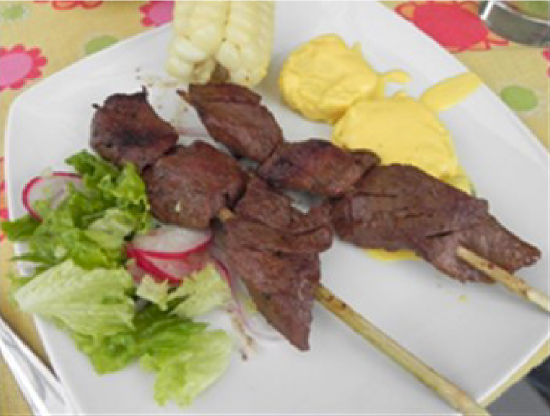
Anticuchos - Wikipedia Commons
Tongue: The surface of the tongue is very coarse and requires a long period of slow cooking to be able to remove it (six to eight hours of simmering). Once skinned, the tongue can be sliced and is quite tender. There is a very large amount of gelatin in the meat which provides a rich flavor. It is often pickled or corned before cooking
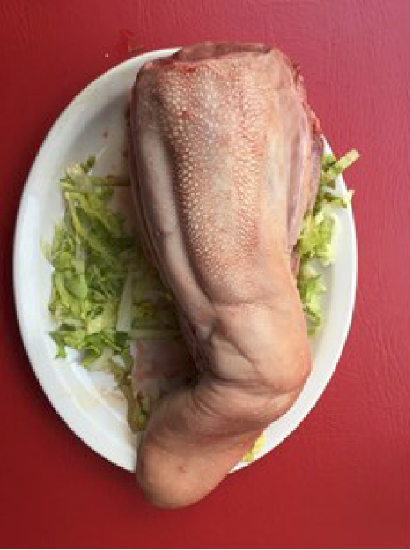
Cow tongue - Max Pixel
Tripe: Tripe is processed from the muscular inner lining of the stomach. It can be smooth or honey-combed depending on which chamber of the animal’s stomach it is harvested from. It is commonly sold fresh or pickled. Washed tripe, also known as dressed tripe, is boiled and bleached, giving it the white color more commonly seen for sale. Tripe requires moist heat cookery to break down its rubber-like texture. It is most commonly used in soups and stews.
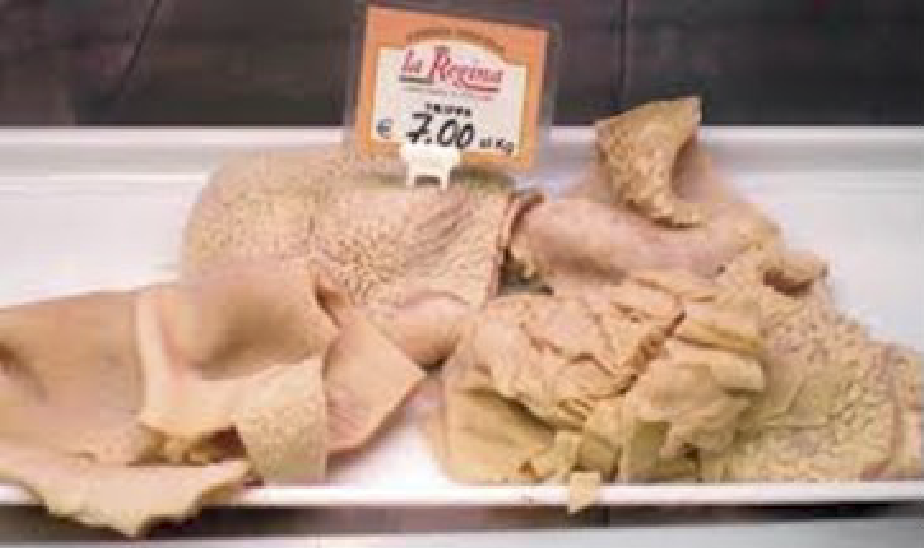
Tripe - Wikimedia.org
Sweetbreads: Sweetbreads are the thymus glands of calves and mature beef. They are pinkish-white in color. Veal or calf sweetbreads are considered a great delicacy. They are largest in size when the calf is five to six weeks old and decrease in size as the animal ages. Sweetbreads should be thoroughly soaked in cold water, then blanched so that the membrane can be removed. They then can be braised, or cooled then sliced and breaded for pan frying.
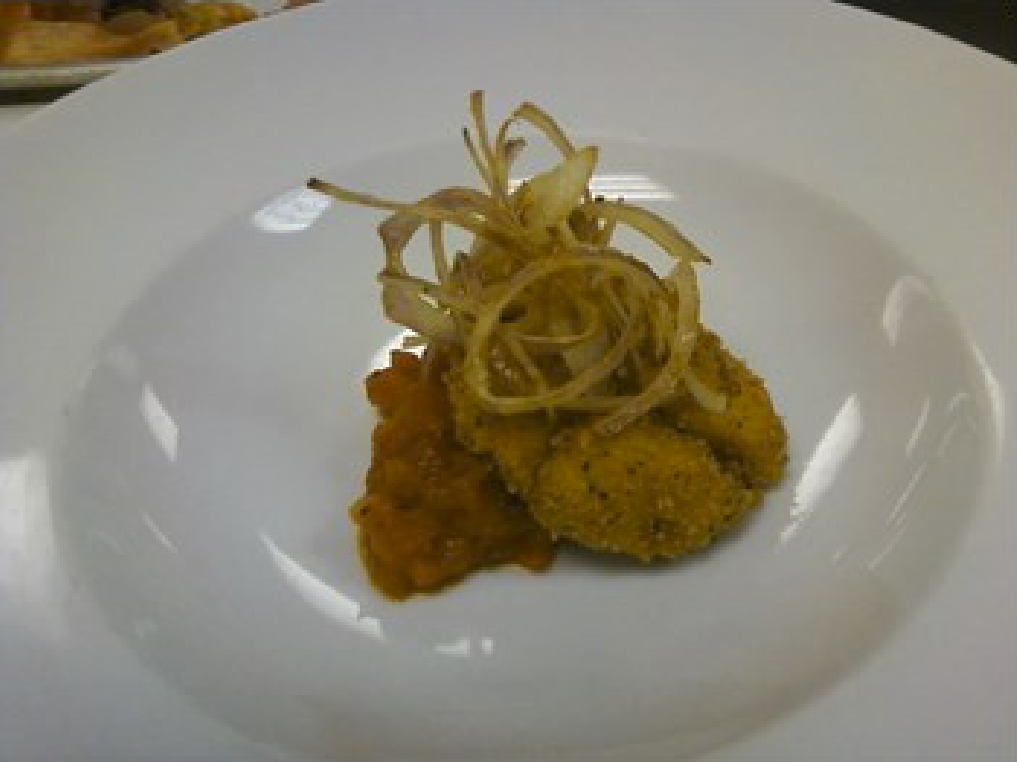
Veal sweetbreads with fried onions and tomato ragu - photo Chef Marshall Welsh CEC
Brain: Brains are a small volume seller. They perish very quickly so are generally frozen at the plant as soon as they are harvested from the animal. They are mild in flavor and have a delicate texture. Calves brains are most commonly used. They can be prepared much the same as sweetbreads. Brain is extremely high in cholesterol.
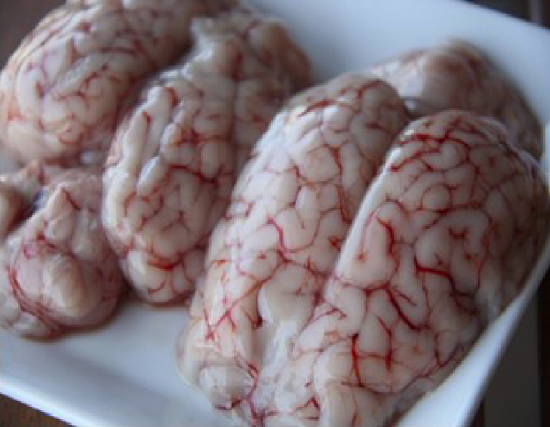
Lamb brains- Wikimedia commons
Oxtail: Oxtail is classified as offal even though it is not an internal organ. Oxtail is mainly used for making soup to extract its rich flavors. It is more bone than meat, but the meat from the oxtail, once properly braised, is very rich in flavor
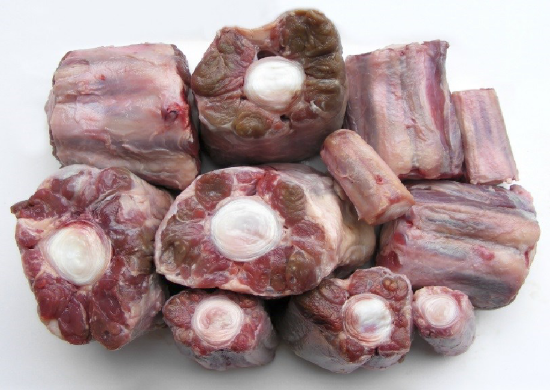
Oxtail - Wikimedia Commons
Cheeks and head: These are not technically offal, but increasingly popular are beef and veal cheeks, while pork heads are used to make headcheese, a type of sausage consisting of the meat from the head set in a gelatin base made from the cooking liquid.
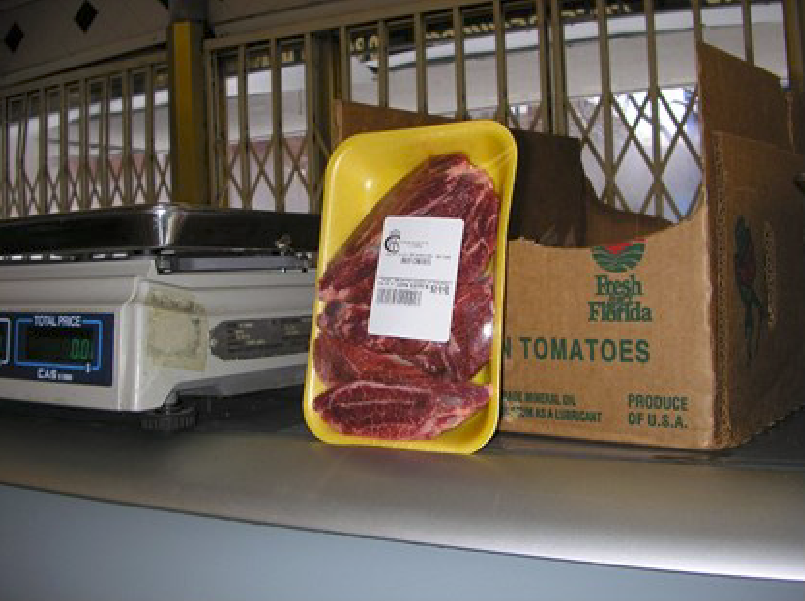
Beef Cheeks in a retail pack - Wikimedia Commons
Caul fat: Fine membrane of fat which covers the stomach of hogs, Caul fat is used for barding (wrapping or covering) lean cuts of meat, ground fillings and sausage meat.
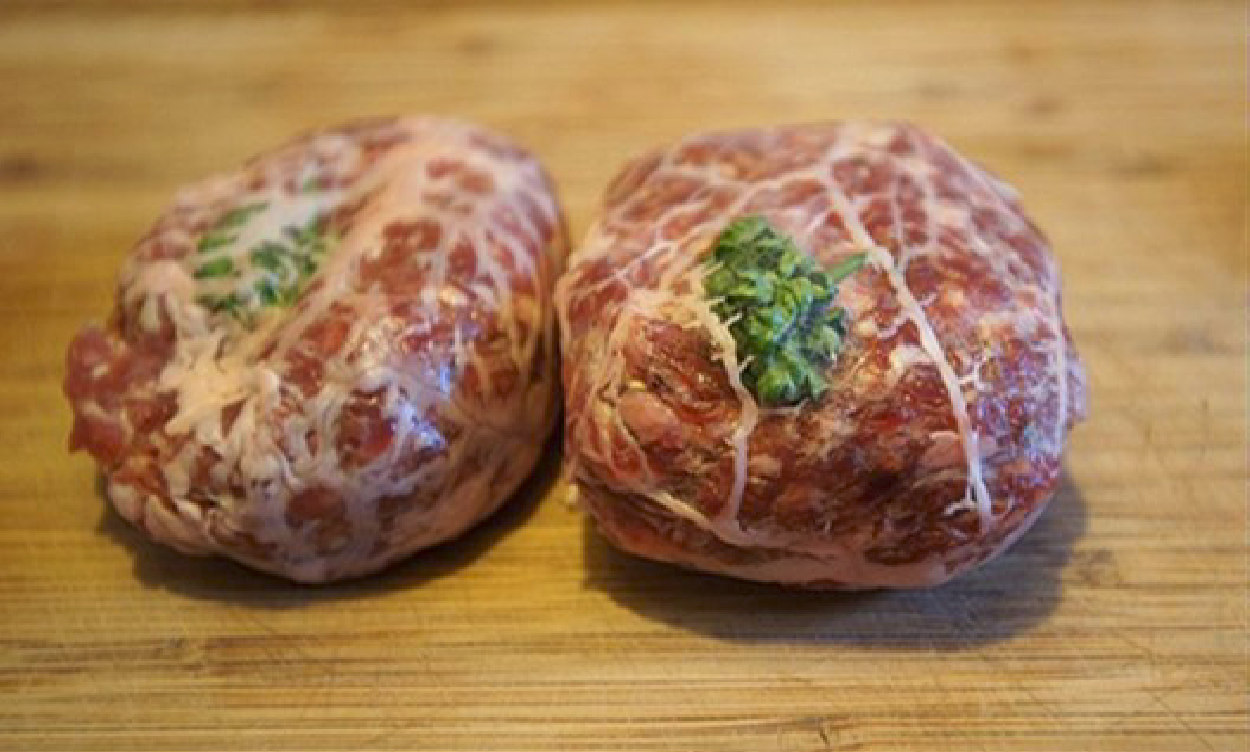
Ground pork wrapped in Caul Fat - Wikimedia Commons
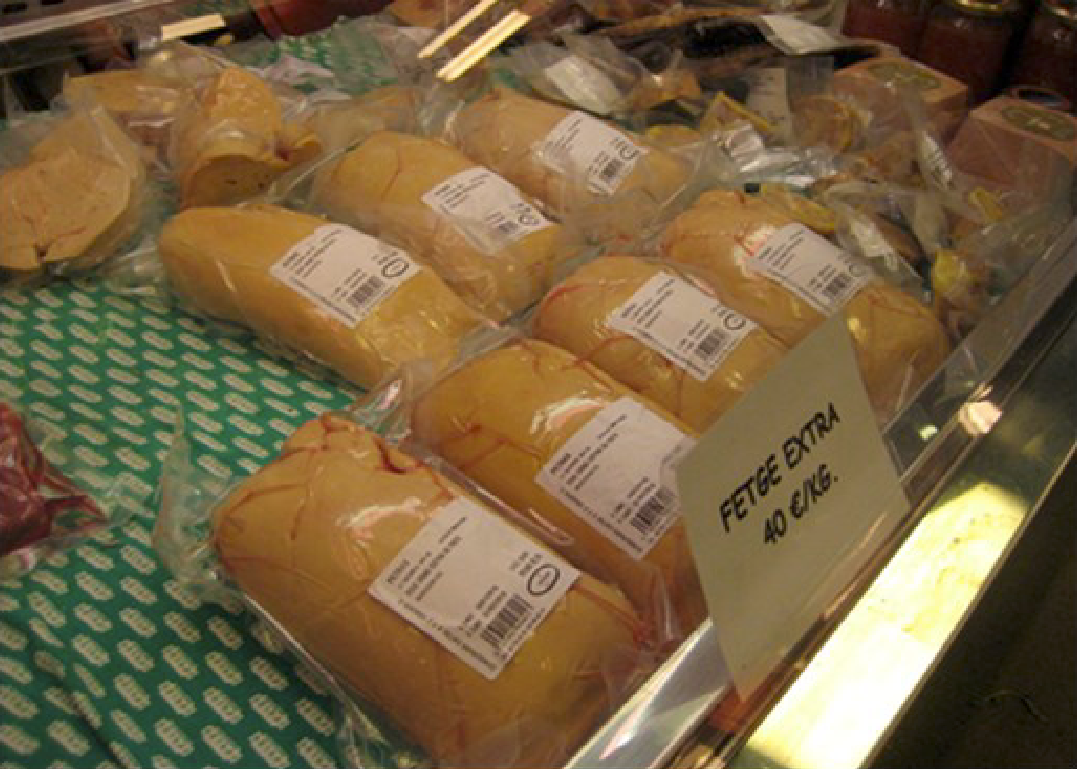
Foie Gras at market in raw form - Flickr
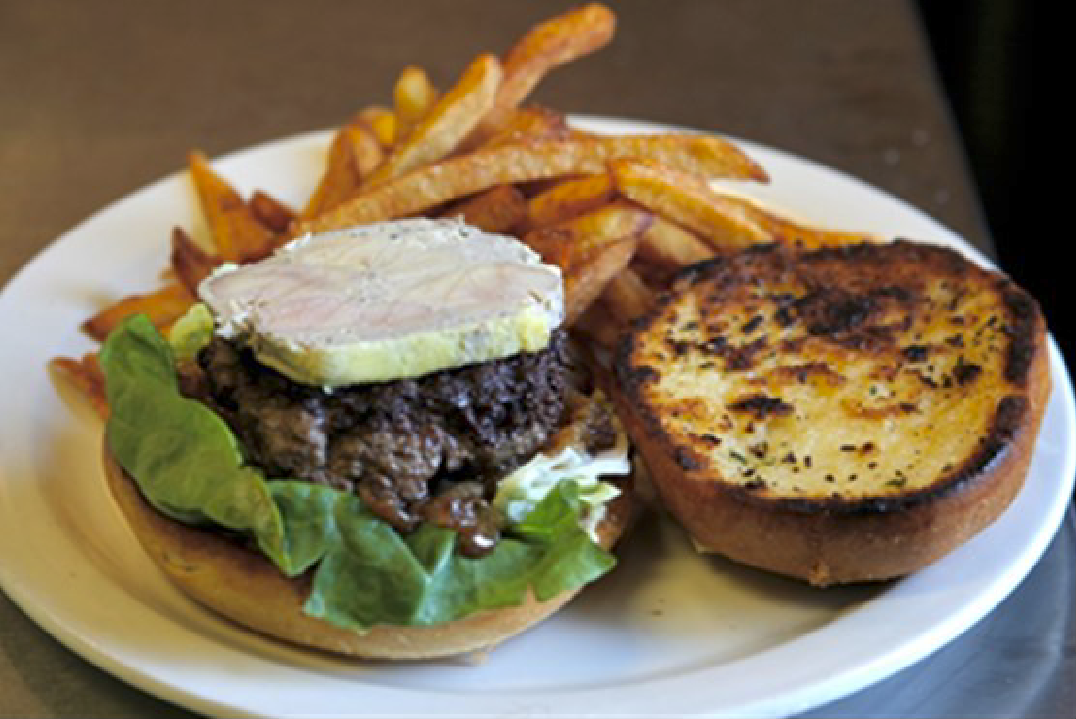
Ground Kobe Burger with Torchon du Frio Gras - Flickr
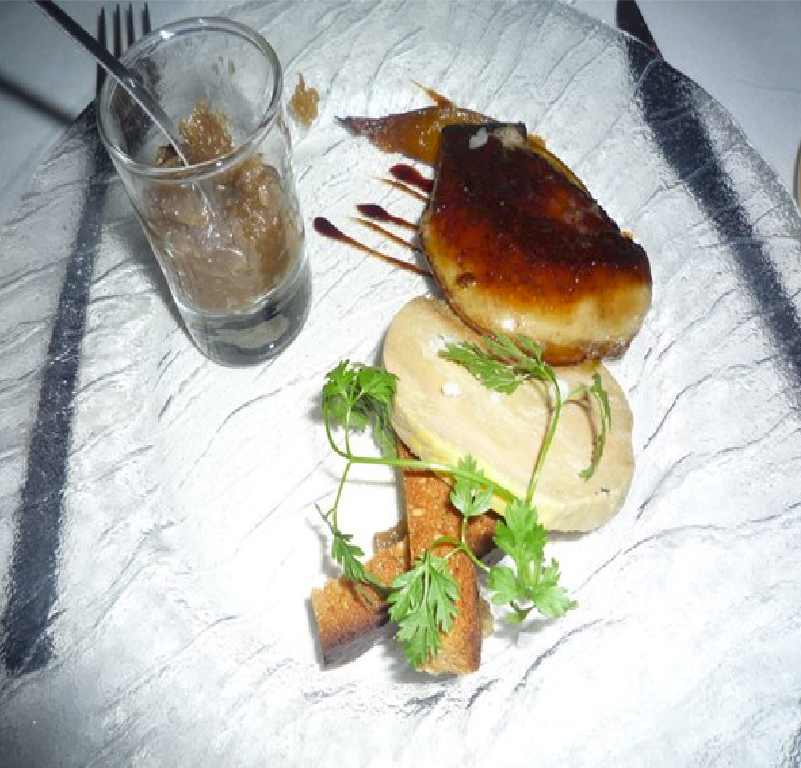
Duo of Foie Gras torchon and Seared Foie Gras with Gastrique - Flickr
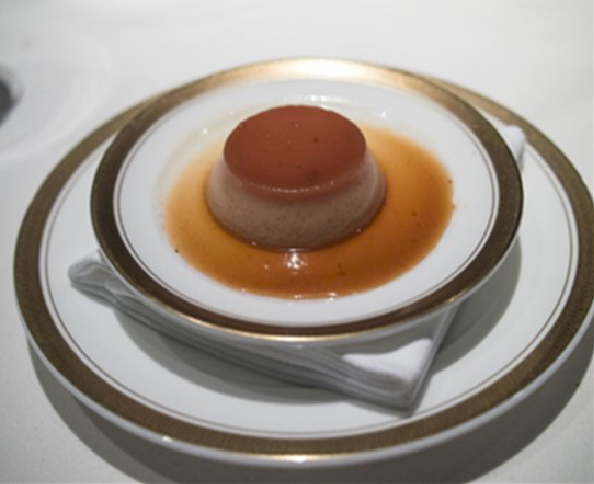
Flan of Foie Gras at el Bulli - Flickr
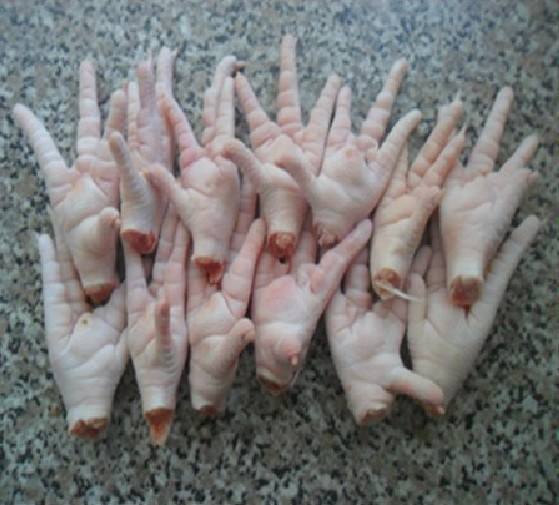
Chicken Feet - Wikimedia Commons


